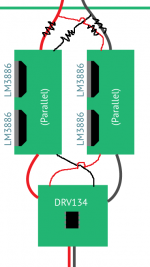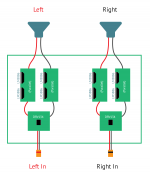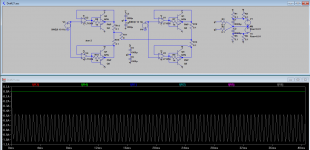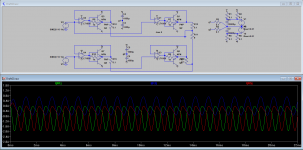Howdy!
I have exactly 8 x LM3886s and 2 x DRV134 floating around in my collection, and I'd like to put it all together into a single, monstrous amplifier.
My idea is to create 4 duplicate parallel (PA100) boards (each with 2 LM3886s). Then, using a pair of DRV134s, bridge them together in pairs for each speaker, like in the attached image.
I see @danielwritesbac mentioned this setup here, but has anyone given this a shot? I can find plenty on the "standard" BPA200 and PA100, but in this layout is there anything I should be aware of, pitfalls, problems?
Thanks!
I have exactly 8 x LM3886s and 2 x DRV134 floating around in my collection, and I'd like to put it all together into a single, monstrous amplifier.
My idea is to create 4 duplicate parallel (PA100) boards (each with 2 LM3886s). Then, using a pair of DRV134s, bridge them together in pairs for each speaker, like in the attached image.
I see @danielwritesbac mentioned this setup here, but has anyone given this a shot? I can find plenty on the "standard" BPA200 and PA100, but in this layout is there anything I should be aware of, pitfalls, problems?
Thanks!
Attachments
Your idea is pretty good. Building four boards and testing them before cobbling everything together is a very good idea. Run the amp on ±28 V and you'll be fine, even with a 4 Ω load. If you want to get up to ±36 V, you'll need three LM3886es per side to support the output current. That's basically what I do in my Modulus-686. I then add error correction to drive the distortion to levels way below the noise floor, but that's beyond the scope here, I think.
There are many pitfalls: Stability, decoupling, power supply sequencing, DC offset balancing just to name a few. I suggest starting with my Taming the LM3886 article series: Taming the LM3886 Chip Amplifier
Tom
There are many pitfalls: Stability, decoupling, power supply sequencing, DC offset balancing just to name a few. I suggest starting with my Taming the LM3886 article series: Taming the LM3886 Chip Amplifier
Tom
Great, thanks @tomchr! I've devoured all the content on your site - thanks for all the generous info!
Yeah, I'm going to start with a few prototype parallel LM3886 boards, tweak the design until I get something I'm happy with, and then attempt to bridge the pairs.
Question: When building the LM3886 boards, would there need to be any difference in construction between the boards driving the positive signal and the boards driving the negative signal (i.e. any polarity considerations)? Or is it just the case that I'd feed the corresponding output from by DRV134s into identical LM3886 boards? Obviously, if I could make 4 absolutely identical LM3886 boards that would be ideal.
Yeah, I'm going to start with a few prototype parallel LM3886 boards, tweak the design until I get something I'm happy with, and then attempt to bridge the pairs.
Question: When building the LM3886 boards, would there need to be any difference in construction between the boards driving the positive signal and the boards driving the negative signal (i.e. any polarity considerations)? Or is it just the case that I'd feed the corresponding output from by DRV134s into identical LM3886 boards? Obviously, if I could make 4 absolutely identical LM3886 boards that would be ideal.
Dual 3886 in balanced mode
Hey Tom, I hoped you'd show!
What are the pros and cons of running each dual 3886 board in balanced mode and then summing them?

I always liked 2 chips in balanced mode because each chip is pulling from a different ps cap and cancelling common signals on a small dual pcb. Since the + and - signals share more twisted cabling and more common real-estate on a single small pcb, is the common mode rejection better?

But I'm not sure of gnding issues ...
Cheers
Hey Tom, I hoped you'd show!
What are the pros and cons of running each dual 3886 board in balanced mode and then summing them?

I always liked 2 chips in balanced mode because each chip is pulling from a different ps cap and cancelling common signals on a small dual pcb. Since the + and - signals share more twisted cabling and more common real-estate on a single small pcb, is the common mode rejection better?

But I'm not sure of gnding issues ...
Cheers
Last edited:
I saw a diagram for this circuit in a Texas Instruments tutorial. I wish I had the link for you. I've been thinking about building something like this ever since.
With the parallel chips I don't think it's a slam dunk to work right the first time. I experimented with parallel LM1875 and you have to adjust the offset before you parallel them. Precision, high stability resistors are a must. You might think about using servos.
I hope you get it to work.
With the parallel chips I don't think it's a slam dunk to work right the first time. I experimented with parallel LM1875 and you have to adjust the offset before you parallel them. Precision, high stability resistors are a must. You might think about using servos.
I hope you get it to work.
@audiolapdance: actually, the two way of doing it aren't completely equivalent. There are way less circulating currents in between the boards and power supply using two bridged pcb rather than two parallel pcb.
Here are the simplified sims. To simulate two pcbs, two "amps" are using the same supply (+1/g1/-1 r +2/g2/-2). Those supplies are tied to main caps through 0.1r resistors to visualize the currents. There are bypass caps (1000uf) on each "pcb".
If using two pcb with // amps, there are quite heavy currents circulating in the wiring between the pcbs and the psu. If using two pcb with bridged amps, they are much reduced.
Would it matter in real life ? No idea to be true. I attach the asc files in case someone wants to verify I didn't mess up the sims.
Here are the simplified sims. To simulate two pcbs, two "amps" are using the same supply (+1/g1/-1 r +2/g2/-2). Those supplies are tied to main caps through 0.1r resistors to visualize the currents. There are bypass caps (1000uf) on each "pcb".
If using two pcb with // amps, there are quite heavy currents circulating in the wiring between the pcbs and the psu. If using two pcb with bridged amps, they are much reduced.
Would it matter in real life ? No idea to be true. I attach the asc files in case someone wants to verify I didn't mess up the sims.
Attachments
- Status
- This old topic is closed. If you want to reopen this topic, contact a moderator using the "Report Post" button.
- Home
- Amplifiers
- Chip Amps
- 8 x LM3886 with 2 x DRV134 feasibility?


